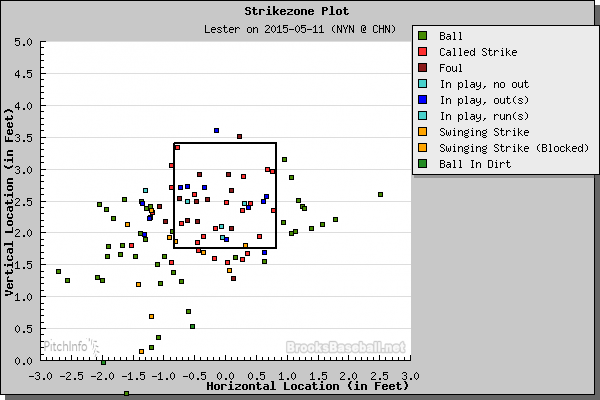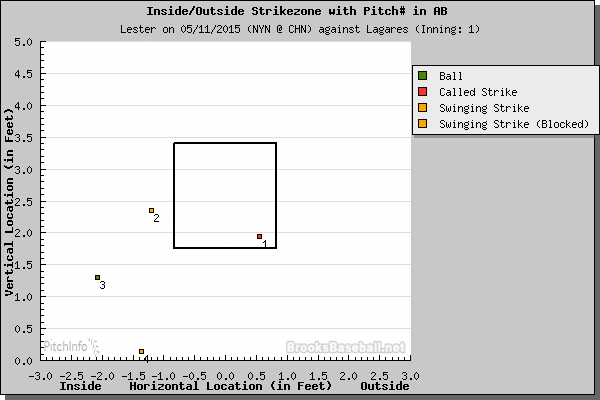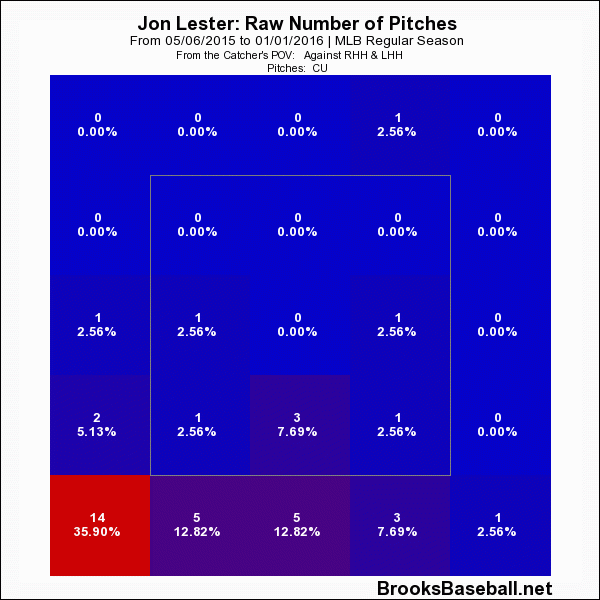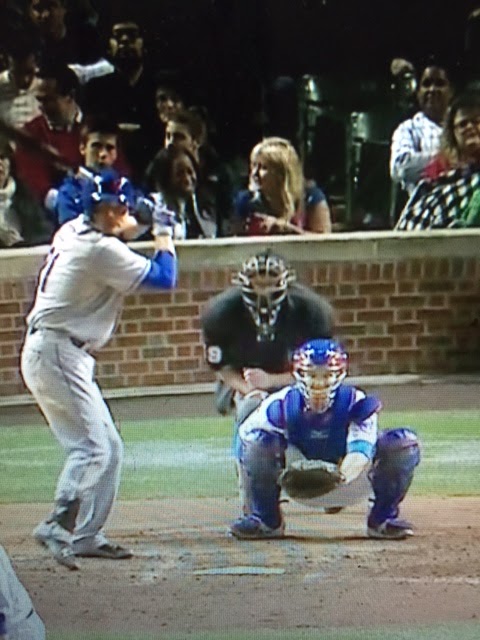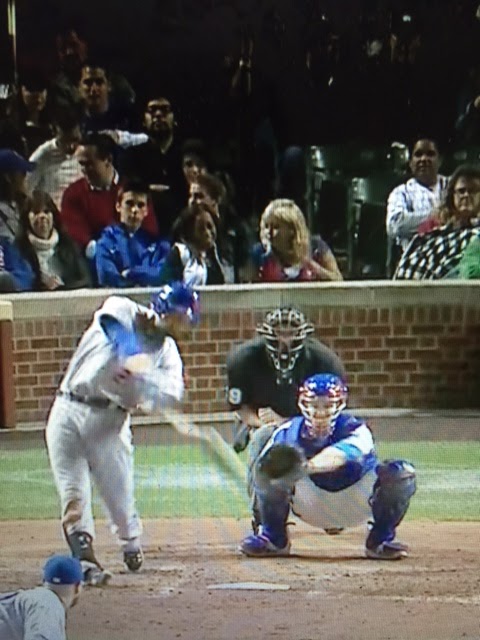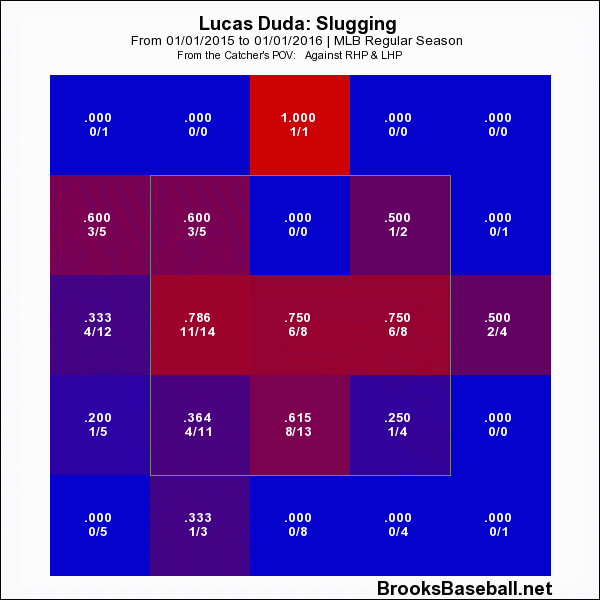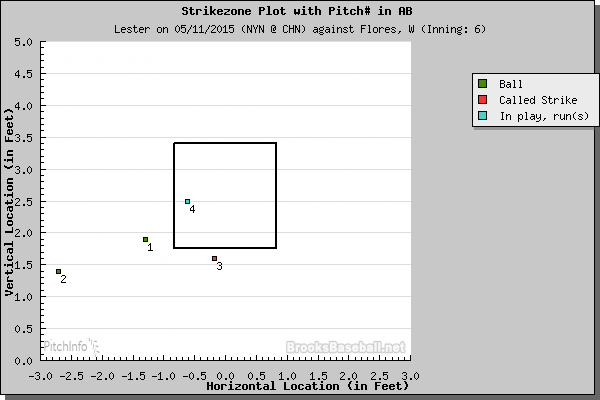Photo courtesy of Caylor Arnold-USA TODAY Sports
Date: May 11
Opponent: New York Mets
Location: Wrigley Field
Introduction
- Santa Claus/Hanukkah Harry
- A White Russian and waffle fries at Redmond’s
- The first three innings of Monday night’s game
Oh, don’t mind me. I was just busy updating my list of life’s greatest things.
Well, that was pretty damn fun, huh? The sun was shining. The reigning NL Rookie of the Year was taking the mound opposite the Cubs no. 1 starter. The newly KRIStened bleachers (thanks to BP-Wrigleyville contributing writer Zack Moser for the least corny pun of all time) were buzzing.
It was springtime baseball on the North Side between two playoff contenders, and the atmosphere could not have felt more electric, even from a MLB.tv feed on a Mac Book roughly 950 miles east of the stadium.
And for the first three innings, Jon Lester was rising to the occasion. He was spotting his four-seam fastball to get ahead of Mets batters, much like in his preceding two starts against the Cardinals and Brewers. Lester and David Ross were going to the curveball frequently and successfully (see Trends section). His cut-fastball still was not sharp, but the Mets were not hammering the mistakes. Lester allowed just two baserunners and 47 pitches to get through the first three innings.
Innings four, five, and six were not as smooth, with Lester requiring 63 pitches to get through the final three innings, allowing six baserunners and two home runs in the process. He would throw a season high 110 pitches to get through six innings. Once again, though, Lester continued to improve on his sluggish start to the season.
First and foremost, Lester got ahead of 18 of 27 batters (67 percent), making it the second consecutive game he jumped ahead of two-thirds of the opposing batters. Like his last start, when he got ahead of 68 percent (21/31) of Cardinals batters, he was using his fastball to get up early in counts (see Pitch Breakdown section).
The Mets entered the game struggling offensively, owners of the fourth-lowest team OPS in the National League (.660). The Mets scored eight runs at the New York Yankees on April 25. In the proceeding 12 games, the Mets scored just 27 runs. On Sunday, they broke out a bit scoring seven runs at Philadelphia.
As a team, the Mets entered hitting .243/.315/.364 against left-handed pitchers, and started seven right-handed batters on Monday. Lucas Duda, though, has been exceptional against left-handed pitchers this season, hitting .379/.438/.515. He entered 5-for-7 against four-seam fastballs from lefties, the pitch Lester has thrown most frequently in 2015 (43.6 percent to all batters, 45.7 percent to left-handed batters), which should have foreshadowed the four-seamer he destroyed in the sixth inning.
The Mets opted not to start left-handed batting Curtis Granderson, who despite hitting just .053/.143/.053 against left-handed pitchers this season, has had decent success against Lester. In 44 career plate appearances, Granderson has hit .275/.341/.525 with two home runs. When you also factor in Lester’s well-documented struggles against left-handers in 2015 (.349/.378/.535), it was a bit of a surprise.
Nevertheless, Lester took care of business against the lineup the Mets fielded. How did it go down? Keep reading below, because much like a Kris Bryant home run flying into the left-center field wind tunnel, this keeps going and going.
Traditional Line
6.0 IP, 5 H, 6 K, 3 BB, 3 ER
Pitch Breakdown
110 pitches (65 strikes)
| Total | Velocity (Max) | AVG | SLG | BABIP | |
| Four-Seam | 41 | 93.3 (95.2) | .429 | 1.286 | .200 |
| Cutter | 39 | 89.9 (92.3) | .200 | .200 | .250 |
| Sinker | 7 | 92.2 (93.0) | .000 | .000 | .000 |
| Change-Up | 1 | 85.5 (85.5) | .000 | .000 | .000 |
| Curveball | 22 | 75.6 (78.4) | .000 | .000 | .000 |
In his last start, Lester used his four-seam fastball to get ahead of Cardinals batters. Despite the two home runs surrendered off the four-seamer (see Key Sequence section), Lester again used his four-seam fastball to get ahead 13 of 18 batters, with 12 of the 13 taking a called first strike. This allowed Lester, for the second consecutive start, to expand the strike zone and induce swings on pitches outside of the strike zone, as you will see below:
Lester’s ability to locate his pitches produced the following numbers:
- Whiffs on pitches outside of the strike zone – 8 (season high)
- Called strikes on pitches on the edge of the strike zone – 12
- Outs recorded from pitches outside of the strike zone – 5
We began tracking these numbers in his last start, and we will continue to do so throughout the season.
Lester showed remarkable faith in his cutter, despite seven of the 12 extra-base hits he has given up in 2015 coming off the pitch. Against the Mets he set a season high in both total cutters thrown (39) and percentage of total pitches (35.5 percent). Mets batters managed just two singles, but all three walks came on cut fastballs they laid off.
Trends
For the season’s first month, with Lester’s cut fastball spending so much time over the middle of the plate it was splitting rent with his splitter, we screamed to the baseball internet heavens about Lester and Ross refusing to go to the curveball with greater frequency. It seems our cries had been heard in his past two starts.
Lester threw a total of 61 curveballs (12.9 percent of all pitches) in his first five starts, with opposing batters going just 1-for-10 with five strikeouts. If the pitch is so effective, I reasoned, why not go to it more often?
Well, he has now thrown 39 (18 percent of all pitches) in the past two games and for the season, he has now gone to the curve 14.5 percent of the time. On Monday night, Mets batters were hitless against the curveball, with four of six strikeouts coming against the pitch. So, what’s changed?
Now, I’m no fancy big-city baseball scientist, but I will make the following bold declaration (#HotTake?):
There appears to be a correlation between Lester’s improved command of his fastball and his ability to utilize it to get ahead of batters, and his increased use of his curveball.
In April, as we documented heavily, Lester was leaving his four-seam, cut, and sinking fastballs out over the plate with regularity, especially to left-handers. Batters were laying off pitches off the plate, knowing that Lester was likely to come back over the strike zone. During April, Lester was getting ahead of only 51.6 percent of batters, meaning he was often falling behind in the count and abandoning his breaking and off-speed pitches. He was predictable to a fault.
In May, though, Lester is getting ahead of 64.3 percent of batters (54 of 84). Of those 54 batters, Lester has used his three fastballs to get ahead of 48 (89 percent). Whether directly or indirectly, this has led to increased curveball usage.
This was evident from Monday’s first batter, Juan Lagares. Lester opened the game with a four-pitch strikeout of Lagares. Because he was able to locate his four-seam fastball on the corners, Lester was able to set-up the curveball for the strikeout:
This is indicative of his past few starts, when Lester has done an exceptional job of keeping the curve down, where minimal damage can be done:
To me, this increased effectiveness raised an interesting question: Is greater curveball frequency a solid indicator of a better Jon Lester?
For example, look at 2014, when Lester set career-best marks in WHIP, ERA, FIP, and opponent’s OBP, SLG, and OPS. Last season, Lester threw his curveball 16.38 percent of all pitches, the third-highest total of his career. From June 1 through the season’s end, though, the frequency jumped to 19.1 percent. During that 21 start stretch, opposing batters hit just .160 with five extra-base hits. In those starts, he threw 20 or more curveballs in a game on 12 occasions, including 93 total in a three-game stretch in September.
Below, in order from highest to lowest, is Lester’s best seasons by WARP, along with the frequency with which he threw curveballs:
| Season (WARP) | Curveball Frequency |
| 2009 (5.3) | 19.35% |
| 2014 (4.2) | 16.38% |
| 2010 (3.8) | 15.82% |
| 2008 (3.1) | 17.16% |
| 2013 (2.7) | 11.95% |
| 2011 (2.2) | 13.41% |
| 2012 (1.2) | 14.31% |
As you can see, Lester’s best seasons have come when his curveball frequency has been greater than 15 percent. What does this mean, at least without breaking down each of his 259 regular season starts pitch-by-pitch?
As we saw in his first two starts of 2015, at home against the Cardinals and Reds, when Lester is struggling, he abandons his curveball and relies almost exclusively on his fastballs. Even if his four-seamer, cutter, and sinker are not effective, Lester has a tendency to abandon his breaking and off-speed pitches and rely on speed. When he is going well, locating his fastballs to get ahead of batters, he will go to the curve.
Obviously, there are several factors that go into a pitcher’s success, but it is an indisputable fact that Lester’s best seasons have come when his curveball frequency is higher.
Key At-Bat/Sequence
Inning: 6th
Score: 4-1, Cubs
Situation: Bases empty
Batter(s): Lucas Duda and Wilmer Flores
Lester allowed just three base hits through the first five innings. With a 4-1 lead and 84 pitches thrown, he appeared on his way to a third consecutive seven-inning start. That changed in the span of five pitches, as Lester surrendered back-to-back home runs to Lucas Duda and Wilmer Flores, with both coming on four-seam fastballs.
In Lester’s first six starts, he gave up just two home runs. Both were to right-handed batters—Will Middlebrooks and Jhonny Peralta—on cut fastballs that stayed up and caught too much of the plate.
Lester battled Duda to a 1-1 count, with a four-seamer and curveball up and away. Ross then set-up low and away:
Lester, however, came back over the plate with a 94 mph four-seamer:
And when opposing pitchers have come in to the lower half of the strike zone in 2015, Duda has made them pay:
The home run to Wilmer Flores was less an example of locating the fastball poorly, something that plagued Lester throughout April, and just a batter hitting a pitch he usually does not hit. As you will see below, Lester fell behind 2-1, missing his spots badly with a pair of four-seam fastballs before catching the lower half of the strike zone:
While Duda’s home run came on a missed spot, the 93 mph four-seamer to Flores would have hit Ross’s glove, and was in a spot where Flores has not recorded a single hit in 2015. Entering the game, Flores was hitting just .188 and slugging .281 against four-seamers. Flores just got the bat on the ball.
Keep In Mind
I have thrown enough information at you for one start. This KIM © is more of a fun fact. Monday night was only Lester’s second career start versus the Mets, and first since 2006. On June 27 of that season, Lester made his fourth career start and earned the win, but needed 116 pitches to get through five laborious innings. Carlos Delgado, Carlos Beltran, and Eli Morrero homered for the Mets, while Mike Lowell and Alex Gonzalez homered for the Red Sox in their 9-4 victory.
Conclusion
The home runs to Duda and Flores on four-seam fastballs are disappointing. However, he continues to locate his four-seam fastball, allowing him to get ahead of batters and expand the strike zone. His curveball has returned as the dominant third pitch it was in 2014. Despite some scattered hiccups, Lester has looked like a different pitcher the past three or four starts.
Season-to-Date
3-2, 4.10 ERA, 1.34 WHIP, 22.2 K%, 6.7 BB%
Next Start
Saturday, May 16 vs Pittsburgh Pirates (Gerrit Cole)

